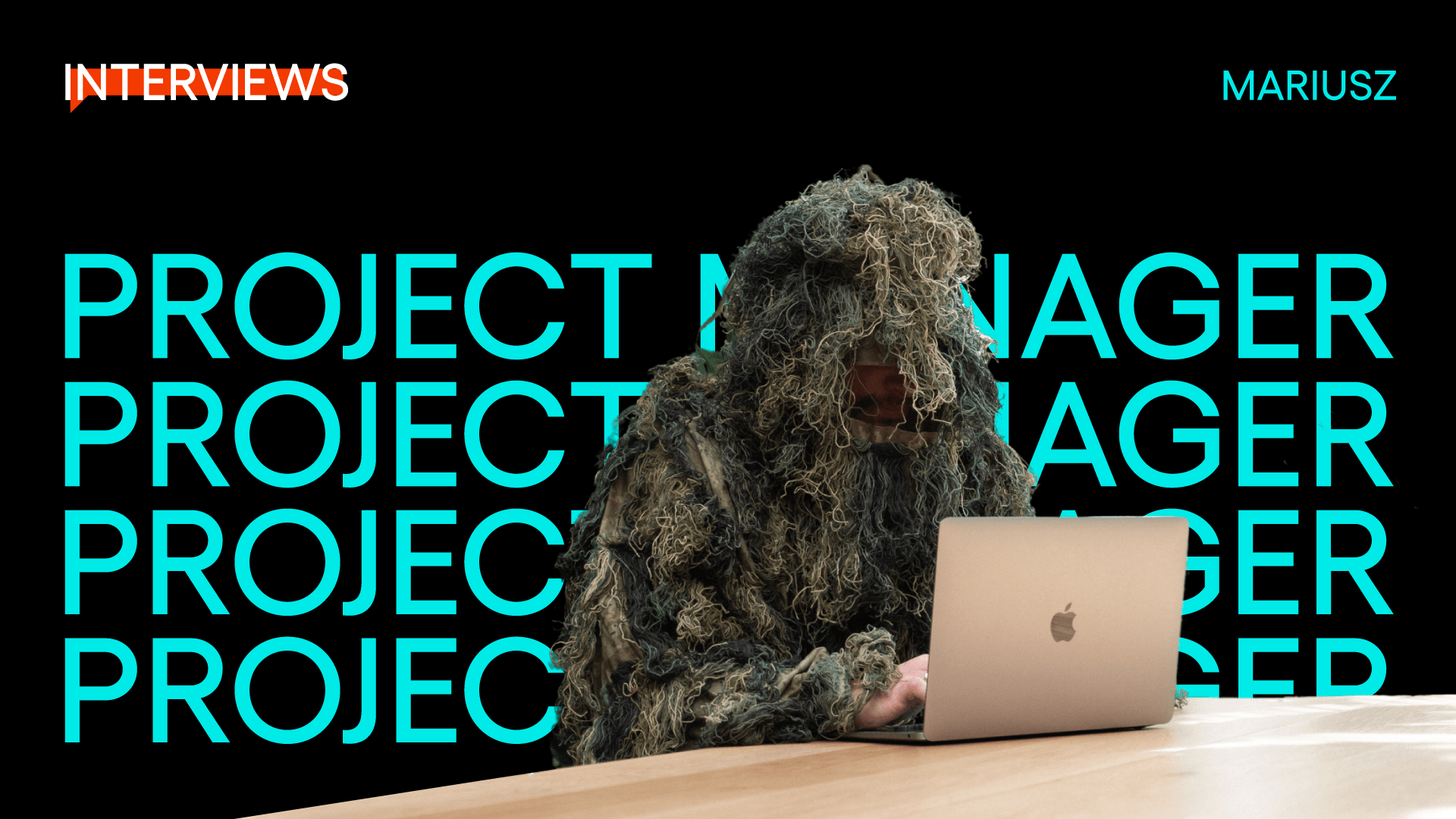#TeamSpeednet: Mariusz, Project Manager


Mariusz has been part of #TeamSpeednet for seven years now. He is a Project Manager at Speednet, but after hours, he takes part in special operations and descends without belay on a rope from a helicopter. We decided to find out more about his experiences and passions.
Hi Mariusz, thanks for taking the time to join our conversation! Let’s start with the most straightforward question. How long have you been working at Speednet?
Mariusz: I’ve been on board since August 2016 and am now in my 7th year. So much for the stats, this adventure sounds more interesting in terms of experience. Let’s split this thread into two stages. Before Speednet, I mainly worked in corporate Fintech. I worked as an analyst, team coordinator, and Product Owner. However, the enthusiasm for working in recognizable companies and serious-sounding positions subsided. I wanted to take a course into more uncharted and inherently less predictable waters, and this is where the second leg of the journey begins. I came to the Speednet interview from recommendation. After the first interview, I was convinced I wanted to join this dedicated and close-knit team, even though I had no prior knowledge of the company. I also knew it would be a big challenge, because of running several projects simultaneously in different technologies and for various industries. Where there is a challenge, motivation is also born, and so after more than 2,150 days, the horizon continues to open up new adventures and events. All thanks to the exceptional people with whom no storm is terrible.
Seven years is a long time. Please tell me more about your role as Project Manager. Who are you, and what do you do?
Mariusz: I’m a man employed as a Project Manager, known as a PM for short. It’s a proxy between the client and the engineering team. Someone who translates visions into requirements, speaks the language of priorities, and juggles between business, operational, and strategic goals. When a potential client comes in with their idea, the Project Manager coordinates the initial work to prepare the budget and schedule. Thanks to the presales, we know what is going on in the market – once we educate clients, and at other times, we learn about inspiring solutions ourselves. The full-time job of a project manager is… to run projects. Under this unpronounceable umbrella is responsibility for punctuality, quality, and finances. When you add the fact that virtually no project is the same and Murphy’s Law reminds you of itself at every turn, you have quite a mix. This is what I like about working in a Software House.
A minimum of routine, constantly looking for improvements, neutralizing problems/threats. At Speednet, each Project Manager has their style and standard of work. Our predispositions and previous experience are considered when assigning us further projects. There was a time when if something came to me, the project qualified as… exceptional (laughs). And why do you use outsourcing in the IT industry? Lower costs, transfer of knowledge, transfer of responsibility. It requires us to have special training and tactics. We are like an IT SWAT unit we go into action where professionals are needed.
Cool, being a Project Manager sounds interesting, so you are unlikely to complain about boredom at work. What does your typical day at the office look like?
Mariusz: After my morning warm-up, I head to the branch. I undergo authorization in the security area, and after secretly getting to the operations desk, I activate the communication systems and check my equipment. Now, the most dangerous stage begins. I get down to reading emails. This is where the expected or unexpected news usually comes in. As a Project Manager, I optimize the time to the circumstances. It’s one thing to prioritize responses; it’s another to use David Allen’s well-known patent: what I can do at once, I do at once, and delegate the rest to myself for later. Then, a session of several daily in a row begins. We discuss the more difficult threads after the daily in the form of ‘car parks.’ If we still need a solution, we meet later in the day. Stiff, right? That’s why I organize a stretching session at 10:30 every day—15 minutes to improve body and mind flexibility. We practice with a dedicated app, but I smuggle in various patents from Yoga and the physiotherapist.
If it’s Monday and approaching midday, we are closing the sprint and planning a new week or ‘fortnight’ of work. The scope of work needs to be broken down into minor phases to observe progress in short bursts and adapt more flexibly to changes. If the end of a month is approaching, we additionally do a retrospective. Based on experience, we look for new solutions, continue or suspend entitlements already introduced, or take a beating for our inactivity in an area. On the other days, there are client meetings, workshops, one-on-one paperwork, and reviewing project tools. There are PMO meetings or Project Manager conventions when we step outside the project spectrum. We share gossip, information, challenges, and ideas. Each Project Manager also has individual conjunctions with the Head of PMO. We review project parameters, discuss current and future needs, and anticipate the future. Transparent exchange of information from the bottom to the top of the decision-making chain. I also exceptionally value the meetings with the lid. The management has a wealth of technical and business experience, which they share openly. Perspectives often emerge in conversations I need to see at the operational level. Speaking of views, most ideas and threads come from the project team itself. We end up spending the most time with each other.
You mentioned the morning warm-ups that you run. I’ve had the opportunity to participate a few times myself; it’s a very cool initiative. Where did the idea for stretching in the office and organizing other, slightly more extreme activities come from?
Mariusz: The inspiration to get active came from other people at Speednet. I had just started work and heard that one employee had crawled out of a team start in a specific obstacle run. I didn’t have the slightest problem running in a sweatshirt with his name on it but covered up with a scarf/vest in incognito mode. At the same event, it still happened once that I ran in every category in which Speednet had representation. It’s not a brilliant idea, but I would be happy to repeat it. Also, with Speednet, I competed in an extreme orienteering event for the first time; we even managed to win it as a team. We have excellent navigators and long-distance runners from whom I can take a cue. When time permits, I also take our Speednet team on excursions in country parks and to abandoned buildings, film short skits announcing stretching, or teach the girls self-defense. In such company, you don’t think about whether to do something, just when. As a herd animal, I will organize these initiatives as long as the team is interested in it. Hopefully for as long as possible and without injury.
As far as I know, running projects is not the only area where you thrive. Tell us a bit about your other hobby, and can you tell us why you are incognito?
Mariusz: You mean preparing ketogenic desserts at the office in a gas suit or working in front of your desk in a gas mask? (laughs). Okay, so you’re asking about my interest in special operations. Even before I started my career in IT, I considered serving in an anti-terrorist unit or special forces. What remained of those plans was a passion that I still pursue today. It’s an interesting story, because I developed it from a group of colleagues running in the woods to a nationwide formation with team victories in extreme sports, shooting and rescue competitions. Although we are civilians, we have participated in training and simulations of combat operations with helicopters, ship boardings on the high seas, and the recapture of hostages from buildings such as offices, schools and shopping malls along with the police. We were trained by commandos, about whom you can now read books. I could talk about it for a long time, but there would probably be more current. Thanks to the fact that I am PM of this organization, I can often adapt the knowledge and skills I acquire to typical professional needs. And to answer your question, it is precisely because of all these activities, among others, that I value maintaining an image of anonymity and operating in the shadows.
Well, and moving on to the last question. Do you see any similarities between the two worlds? I remember at the second edition of the “IT’s easy” event, where you were a speaker, there was a lot of feedback regarding the fact that your lecture made an interesting reference to the military world. Will you tell us how you use the skills you acquire during special operations?
Mariusz: I certainly have a heightened resistance to stress (laughs). Descending without belay several meters on a rope from a helicopter, or feeling the blast of a door being blown up a meter away, I react more calmly to nervous situations. The very confluence of the business and paramilitary worlds was born in my mind when I was simultaneously doing courses in project management and special operations. There were similarities in operating conditions, organization, methodologies, tactics and procedures. It all depends on how creatively one approaches it. Let’s move perhaps to concrete examples.
Communication. This is the area that most often fails. In projects, we have people talking at different levels of abstraction, touching on the subject matter differently. How do you succinctly communicate a task? Using the 5W format (who, what, when, where, why, or, for the less savvy, how). This is how an analyst can get a visionary client to synthesize a process description. With a suitable workshop, a full-fledged User Story can be made from the 5W, and everyone will live happily ever after.
A difficult email? First, describe the situation objectively and without emotion, then define precisely what you want to achieve. Step three is to explain how this can be achieved. Next, determine the equipment, technical, and personnel requirements and, finally, designate who will be responsible for what. A source of inspiration is the NATO battle order format. Interesting fact? The exact form is used by regular and special forces – units such as GROM, Formosa, and JWK. The only difference is who uses it and how. It is similar in our industry. We often use identical solutions, but in a more or less advanced way.
And finally, my latest discovery. How often have we been in a complicated situation, with information chaos and no idea what to do next? To me, this smells of presales or taking over a complex project. Let’s meet IT. An acronym for METT is used by the US Army to help commanders remember the issues involved in planning any operation, i.e., giving structure to different sources of information. Why? To extract critical data and then operate on it when analyzing and creating a plan of action.
Mission – i.e., defining tasks and subtasks. This works nicely, as it sometimes turns out, for example, that a job is not achieving a business objective or that we have a long list of new tasks within the main task.
Enemy – or critical information about our customers. I said that out loud, didn’t I? I called the customer an enemy (laughs). More correctly, it refers to someone outside our organizational structure. What is the significance of this? Because you work differently with a start-up and a corporation, an R&D company, and a factory. Different communication, collaboration, billing, and workshops.
Terrain – or area of operation. It’s a place to interview what environments, machines, and technology stack the client has.
Time – or timeline. Time is money, so to save it for the customer, it is useful to know their time constraints, the impact on other aspects of the business, and the risks of not executing the plan.




